Role of Functional Monomers upon the Properties of Bisphenol A Molecularly Imprinted Silica Films
Abstract
1. Introduction
2. Experimental Section
2.1. Materials
2.2. Instruments and Characterization
2.3. Synthesis of Bisphenol A-Molecularly Imprinted Polymer (BPA-MIP) Films
2.4. Batch Binding Measurements and Regeneration of BPA Films
3. Results and Discussion
3.1. Preparation of the BPA-MIP Films
3.2. Structure of BPA-MIP and NIP Films
3.3. Morphology of BPA-MIP and NIP Films
3.4. Thermal Stability of BPA-MIP and NIP Films
3.5. Optical Properties of BPA-MIP and NIP Films
3.6. Batch Rebinding of BPA on BPA-MIP and NIP Films
3.7. Reusability and Stability of Films
4. Conclusions
Supplementary Materials
Author Contributions
Funding
Institutional Review Board Statement
Informed Consent Statement
Data Availability Statement
Conflicts of Interest
References
- Ensafi, A.A.; Amini, M.; Rezaei, B. Molecularly imprinted electrochemical aptasensor for the attomolar detection of bisphenol A. Microchim. Acta 2018, 185, 265. [Google Scholar] [CrossRef] [PubMed]
- Chang, T.; Yan, X.; Liu, S.; Liu, Y. Magnetic Dummy Template Silica Sol–Gel Molecularly Imprinted Polymer Nanospheres as Magnetic Solid-Phase Extraction Material for the Selective and Sensitive Determination of Bisphenol A in Plastic Bottled Beverages. Food Anal. Methods 2017. [Google Scholar] [CrossRef]
- Dermer, O.C. Encyclopedia of Chemical Processing and Design; McKelta, J.J., Weismantel, G.E., Dekker, M., Eds.; Publisher: New York, NY, USA, 1999; p. 406. [Google Scholar]
- Rubin, B.S. Bisphenol A: An endocrine disruptor with widespread exposure and multiple effects. J. Steroid Biochem. Mol. Biol. 2011, 127, 27–34. [Google Scholar] [CrossRef] [PubMed]
- Quinete, N.; Hauser-Davis, R.A. Drinking water pollutants may affect the immune system: Concerns regarding COVID-19 health effects. Environ. Sci. Pollut. Res. 2021, 28, 1235–1246. [Google Scholar] [CrossRef]
- Available online: http://eurion-cluster.eu (accessed on 8 February 2021).
- Corrales, J.; Kristofco, L.A.; Steele, W.B.; Yates, B.S.; Breed, C.S.; Williams, E.S.; Brooks, B.W. Global assessment of bisphenol A in the environment: Review and analysis of its occurrence and bioaccumulation. Dose Response 2015, 13, 1559325815598308. [Google Scholar] [CrossRef] [PubMed]
- Zhang, C.; Li, Y.; Wang, C.; Niu, L.; Cai, W. Occurrence of endocrine disrupting compounds in aqueous environment and their bacterial degradation: A review. Crit. Rev. Environ. Sci. Technol. 2016, 46, 1–59. [Google Scholar] [CrossRef]
- Leemans, M.; Couderq, S.; Demeneix, B.; Fini, J.-B. Pesticides with Potential Thyroid Hormone-Disrupting Effects: A Review of Recent Data. Front. Endocrinol. 2019, 10, 1. [Google Scholar] [CrossRef]
- Rezg, R.; El-Fazaa, S.; Gharbi, N.; Mornagui, B. Bisphenol A and human chronic diseases: Current evidences, possible mechanisms, and future perspectives. Environ. Int. 2014, 64, 83–90. [Google Scholar] [CrossRef]
- Ma, Y.; Liu, H.; Wu, J.; Yuan, L.; Wang, Y.; Du, X.; Wang, R.; Marwa, P.W.; Petlulu, P.; Chen, X. The adverse health effects of bisphenol A and related toxicity mechanisms. Environ. Res. 2019, 176, 108–575. [Google Scholar] [CrossRef]
- Shehreen, A.; Md Saidur, R.; Myung-Geol, P. Role of Antioxidants in Alleviating Bisphenol A. Biomolecules 2020, 10, 1105. [Google Scholar] [CrossRef]
- Ragavan, K.V.; Rastogi, N.K.; Thakur, M.S. Review-Sensors and biosensors for analysis of bisphenol-A. Trends Anal. Chem. 2013, 52, 248–260. [Google Scholar] [CrossRef]
- Sarbu, A.; Iordache, T.V.; Florea, A.-M. Trends in the Molecular Imprinting of Small Molecules: Organic and Hybrid Polymers. In Molecularly Imprinted Polymers (MIPs): Challenges; Quinn, T., Ed.; NOVA Publishers, Publisher: New York, NY, USA, 2017; pp. 119–174. [Google Scholar]
- Kupai, J.; Razali, M.; Buyuktiryaki, S.; Kecili, R.; Szekely, G. Long-term stability and reusability of molecularly imprinted polymers. Polym. Chem. 2017, 8, 666–673. [Google Scholar] [CrossRef]
- Florea, A.M.; Iordache, T.V.; Branger, C.; Ghiurea, M.; Avramescu, S.; Hubca, G.; Sarbu, A. An innovative approach to prepare hypericin molecularly imprinted pearls using a phyto-template. Talanta 2016, 148, 37–45. [Google Scholar] [CrossRef] [PubMed]
- Mba, E.V.; Branger, C.; Bikanga, R.; Florea, A.M.; Istamboulie, G.; Calas-Blanchard, C.; Noguer, T.; Sarbu, A.; Brisset, H. Detection of Bisphenol A in aqueous medium by screen printed carbon electrodes incorporating electrochemical molecularly imprinted polymers. Biosens. Bioelectron. 2018, 112, 156–161. [Google Scholar]
- Florea, A.M.; Iordache, T.V.; Branger, C.; Brisset, H.; Zaharia, A.; Radu, A.L.; Hubca, G.; Sarbu, A. One-step preparation of molecularly imprinted hollow beads for pseudohypericin separation from Hypericum perforatum L. Extracts. Eur. Polym. J. 2018, 100, 48–56. [Google Scholar] [CrossRef]
- Lazau, C.; Iordache, T.V.; Florea, A.M.; Orha, C.; Bandas, C.; Radu, A.L.; Sarbu, A.; Rotariu, T. Towards developing an efficient sensitive element for trinitrotoluene detection: TiO2 thin films functionalized with molecularly imprinted copolymer films. Appl. Surf. Sci. 2016, 384, 449–458. [Google Scholar] [CrossRef]
- Yang, Q.; Wu, X.; Peng, H.; Fu, L.; Song, X.; Li, J.; Xiong, H.; Chen, L. Simultaneous phase-inversion and imprinting based sensor for highly sensitive and selective detection of bisphenol A. Talanta 2018, 176, 595–603. [Google Scholar] [CrossRef]
- Stoica, E.-B.G.; Gavrila, A.-M.F.; Iordache, T.-V.; Sarbu, A.; Iovu, H.; Sandu, T.; Brisset, H. Molecularly imprinted membranes obtained via wet phase inversion for ephedrine retention. U. P. B. Sci. Bull. 2020, 82, 2. [Google Scholar]
- Gavrila, A.-M.; Iordache, T.V.; Lazau, C.; Rotariu, T.; Cernica, I.; Stroescu, H.; Stoica, M.; Orha, C.; Bandas, C.E.; Sarbu, A. Biomimetic Sensitive Elements for 2,4,6-Trinitrotoluene Tested on Multi-Layered Sensors. Coatings 2020, 10, 273. [Google Scholar] [CrossRef]
- Boysen, R.I.; Schwarz, L.J.; Nicolau, D.V.; Hearn, M.T. Molecularly imprinted polymer membranes and thin films for the separation and sensing of biomacromolecules. J. Sep. Sci. 2017, 40, 314–335. [Google Scholar] [CrossRef] [PubMed]
- Rechichi, A.; Cristallini, C.; Vitale, U.; Ciardelli, G.; Barbani, N.; Vozzi, G.; Giusti, P. New biomedical devices with selective peptide recognition properties. Part 1: Characterization and cytotoxicity of molecularly imprinted polymers. J. Cell. Mol. Med. 2007, 11, 1367–1376. [Google Scholar] [CrossRef]
- Criscenti, G.; De Maria, C.; Longoni, A.; van Blitterswijk, C.A.; Fernandes, H.A.M.; Vozzi, G.; Moroni, L. Soft-molecular imprinted electrospun scaffolds to mimic specific biological tissues. Biofabrication 2018, 10, 045005. [Google Scholar] [CrossRef]
- Ait-Touchente, Z.; Sakhraoui, H.E.E.Y.; Fourati, N.; Zerrouki, C.; Maouche, N.; Yaakoubi, N.; Touzani, R.; Chehimi, M.M. High Performance Zinc Oxide Nanorod-Doped Ion Imprinted Polypyrrole for the Selective Electrosensing of Mercury II Ions. Appl. Sci. 2020, 10, 7010. [Google Scholar] [CrossRef]
- Zhang, Z.; Li, L.; Wang, H.; Guo, L.; Zhai, Y.; Zhang, J.; Yang, Y.; Wang, H.; Yin, Z.; Yixia, L. Preparation of molecularly imprinted ordered mesoporous silica for rapid and selective separation of trace bisphenol A from water samples. Appl. Surface Sci. 2018, 448, 380–388. [Google Scholar] [CrossRef]
- Gavrila, A.M.; Zaharia, A.; Paruch, L.; Perrin, F.X.; Sarbu, A.; Olaru, A.G.; Paruch, A.M.; Iordache, T.V. Highly efficient materials working in tandem against pathogenic bacteria in wastewaters. J. Hazard. Mater. 2020, 399, 123026. [Google Scholar] [CrossRef]
- Bakas, I.; Hayat, A.; Piletsky, S.; Piletska, E.; Chehimi, M.; Noguer, T.; Rouillon, R. Electrochemical impedimetric sensor based on molecularly imprinted polymers/sol-gel chemistry for methidathion organophosphorous insecticide recognition. Talanta 2014, 130, 294–298. [Google Scholar] [CrossRef]
- Huang, J.; Zhang, X.; Lin, Q.; He, X.; Xing, X.; Huai, H.; Lian, W.; Zhu, H. Electrochemical sensor based on imprinted sol-gel and nanomaterials for sensitive determination of bisphenol A. Food Control 2011, 22, 786–791. [Google Scholar] [CrossRef]
- Yang, J.C.; Park, J. Molecular Imprinting of Bisphenol A on Silica Skeleton and Gold Pinhole Surfaces in 2D Colloidal Inverse Opal through Thermal Graft Copolymerizatio. Polymers 2020, 12, 1892. [Google Scholar] [CrossRef]
- Ardekani, R.; Borhani, S.; Rezaaei, B. Selective molecularly imprinted polymer nanofiber sorbent for the extraction of bisphenol A in a water sample. Polym. Int. 2020, 69, 780–793. [Google Scholar] [CrossRef]
- Kalogiouri, N.P.; Tsalbouris, A.; Kabir, A.; Furton, K.G.; Samanidou, V.F. Synthesis and application of molecularly imprinted polymers using sol–gel matrix imprinting technology for the efficient solid-phase extraction of BPA from water. Microchem. J. 2020, 157, 104965. [Google Scholar] [CrossRef]
- Stoica, E.B.; Gavrila, A.M.; Branger, C.; Brisset, H.; Dyshlyuk, A.V.; Vitrik, O.B.; Iovu, H.; Sarbu, A.; Iordache, T.V. Evaluation of molecularly imprinted thin films for ephedrine recognition. Mater. Plast. 2019, 4, 865–874. [Google Scholar] [CrossRef]
- Zhuang, Y.; Zhou, M.; Gu, J.; Li, X. Spectrophotometric and high performance liquid chromatographic methods for sensitive determination of bisphenol A. Spectrochim. Acta A Mol. Biomol. Spectrosc. 2014, 122, 153–157. [Google Scholar] [CrossRef]
- Florea, A.M.; Sarbu, A.; Donescu, D.; Radu, A.L.; Zaharia, A.; Iordache, T.V. The structure effect upon gallic acid re-binding in molecularly imprinted organosilica. J. Sol-Gel Sci. Technol. 2015, 76, 529–541. [Google Scholar] [CrossRef]
- Gao, P.; Wang, H.; Li, P.; Gao, W.; Zhang, Y.; Chen, J.; Jia, N. In-site synthesis molecular imprinting Nb2O5 –based photoelectrochemical sensor for bisphenol A detection. Biosens. Bioelectron. 2018, 121, 104–110. [Google Scholar] [CrossRef] [PubMed]
- Pei, D.-N.; Zhang, A.-Y.; Pan, X.-Q.; Si, Y.; Yu, H.-Q. Electrochemical Sensing of Bisphenol A on Facet-Tailored TiO2 Single Crystals Engineered by Inorganic-Framework Molecular Imprinting Sites. Anal. Chem. 2018, 90, 3165–3173. [Google Scholar] [CrossRef] [PubMed]
- Liu, R.; Feng, F.; Chen, G.; Liu, Z.; Xu, Z. Barbell-shaped stir barsorptive extraction using dummy template molecularly imprinted polymer coatings for analysis of bisphenol A in water. Anal. Bioanal. Chem. 2016, 408, 5329–5335. [Google Scholar] [CrossRef]
- Anirudhan, T.S.; Athira, V.S.; Chithra Sekhar, V. Electrochemical sensing and nano molar level detection of Bisphenol-A with molecularly imprinted polymer tailored on multiwalled carbon nanotubes. Polymer 2018, 146, 312–320. [Google Scholar] [CrossRef]
- Iordache, T.-V.; Sarbu, A.; Donescu, D.; Nicolae, C.A.; Jerca, F.A.; Dima, S.O. Selecting the nature of imprinted molecular organosilica sieves with gallic acid via thermal analyses. J. Therm. Anal. Calorim. 2014, 118, 1039–1048. [Google Scholar] [CrossRef]
- Shaikh, H.; Sener, G.; Memon, N.; Bhanger, M.I.; Nizamani, S.M.; Üzek, R.; Denizli, A. Molecularly imprinted surface plasmon resonance (SPR) based sensing of bisphenol A for its selective detection in aqueous systems. Anal. Methods 2015, 7, 4661–4670. [Google Scholar] [CrossRef]
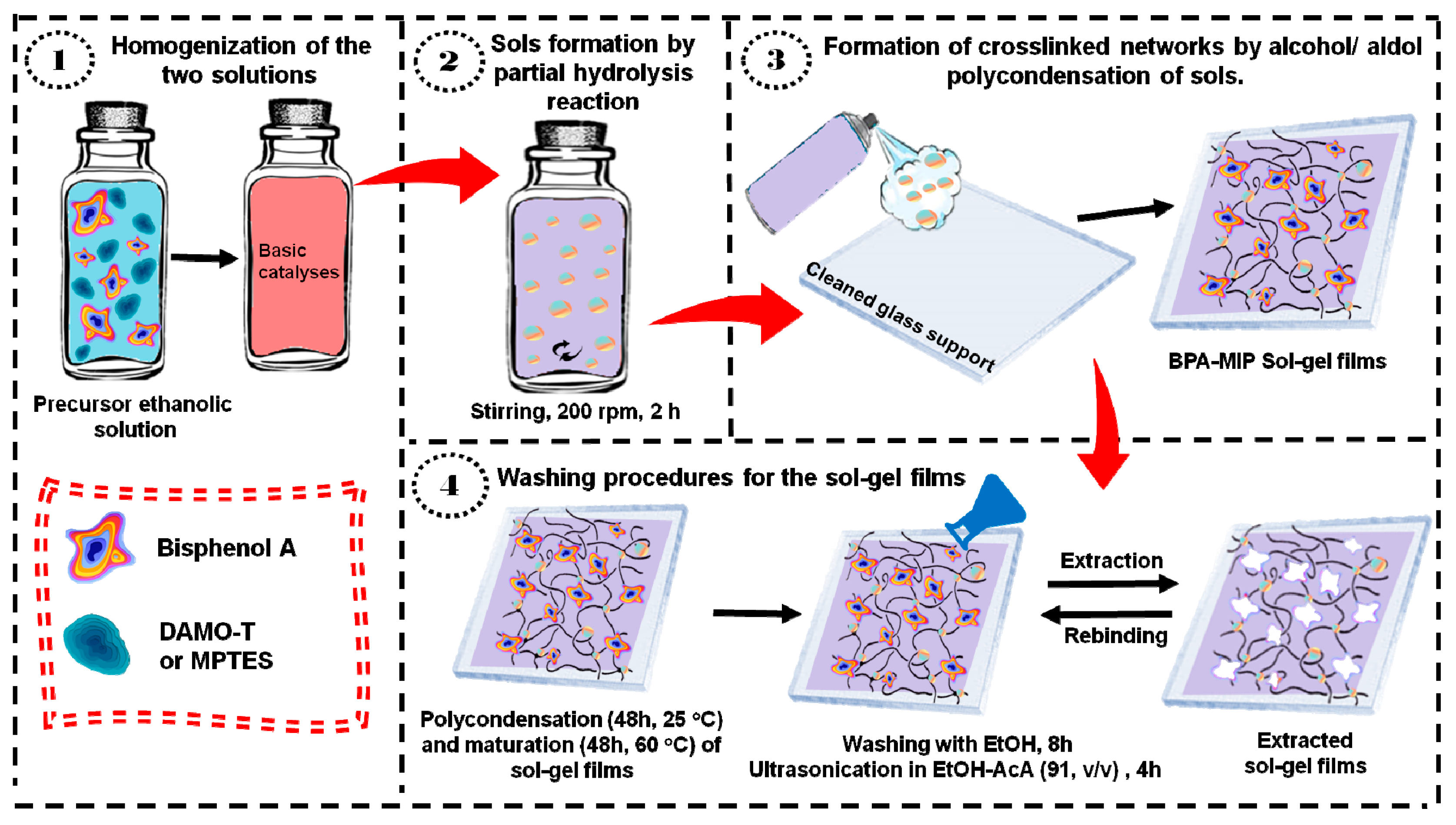
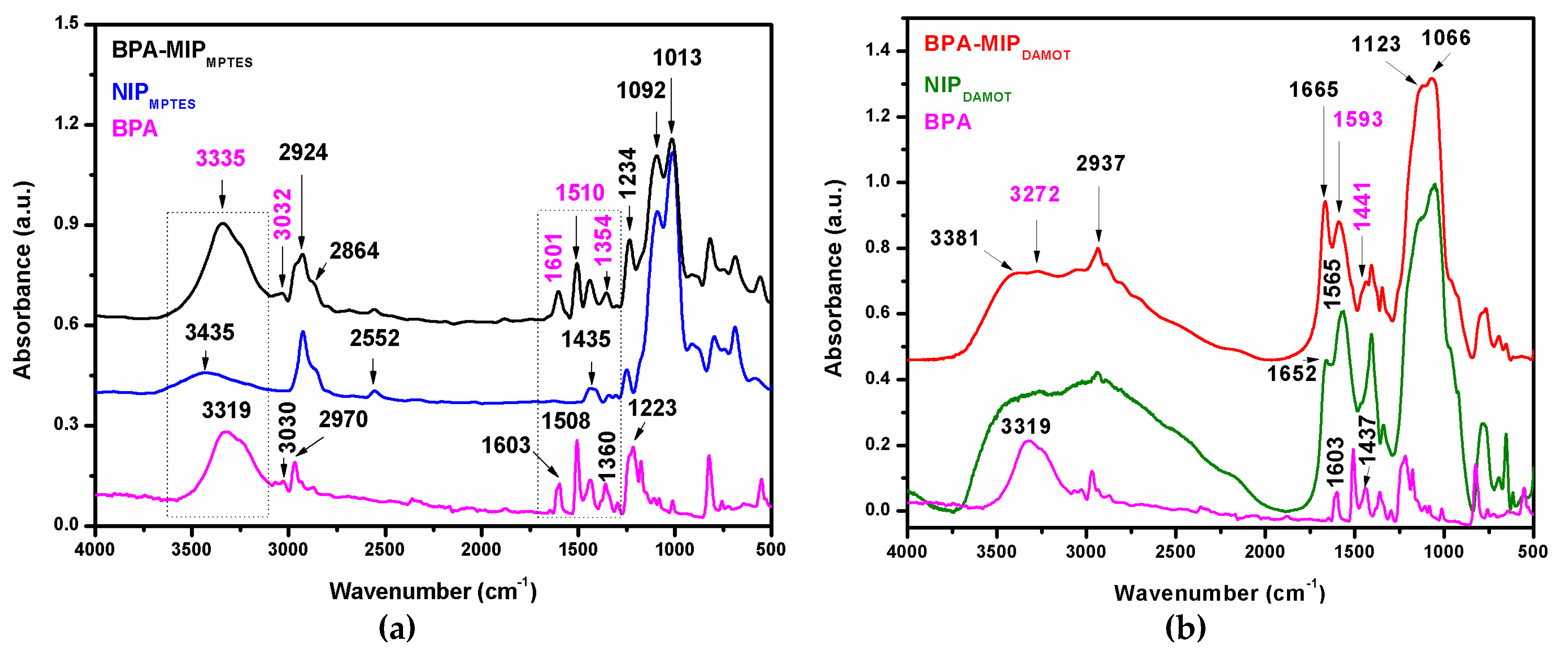
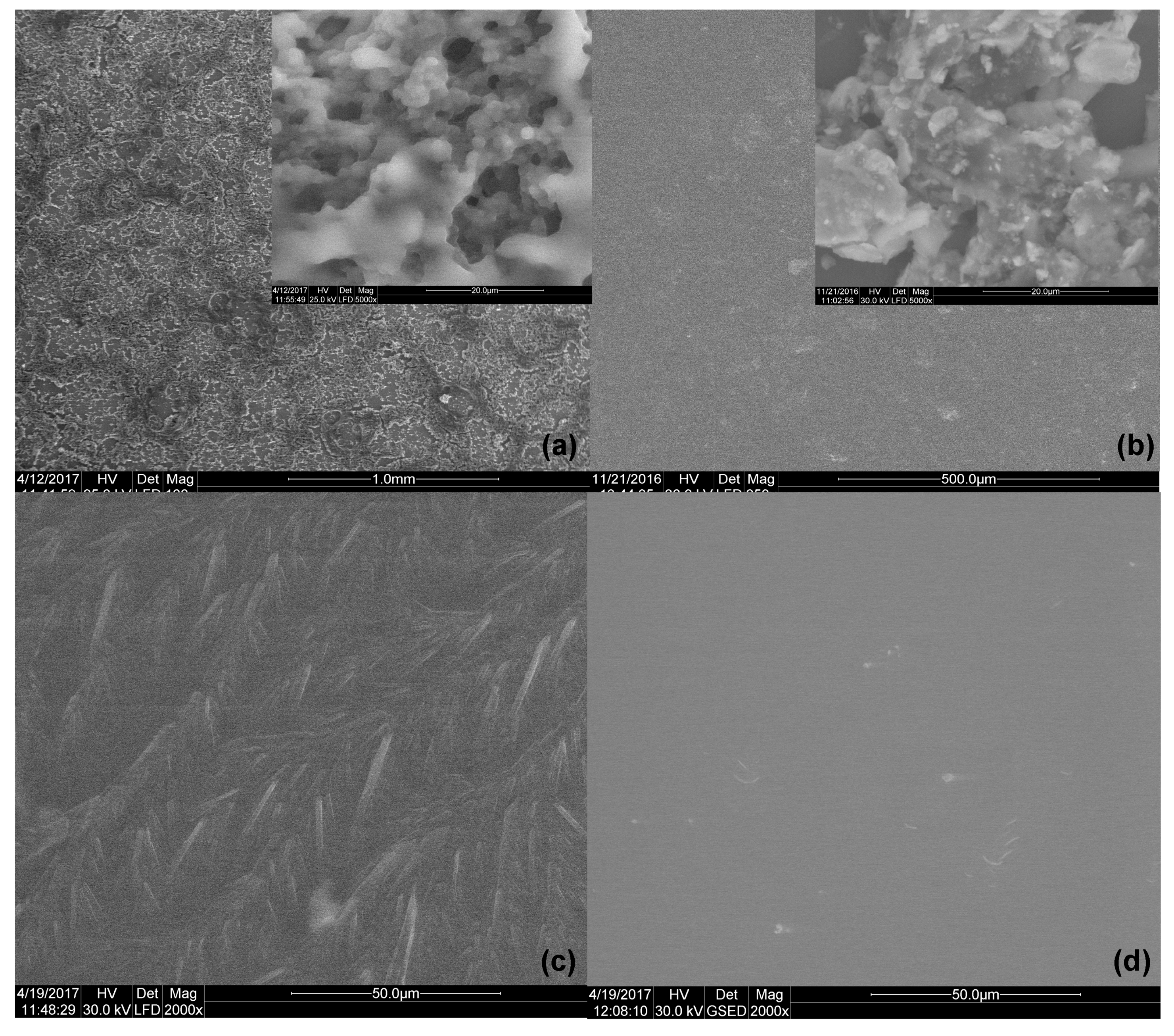
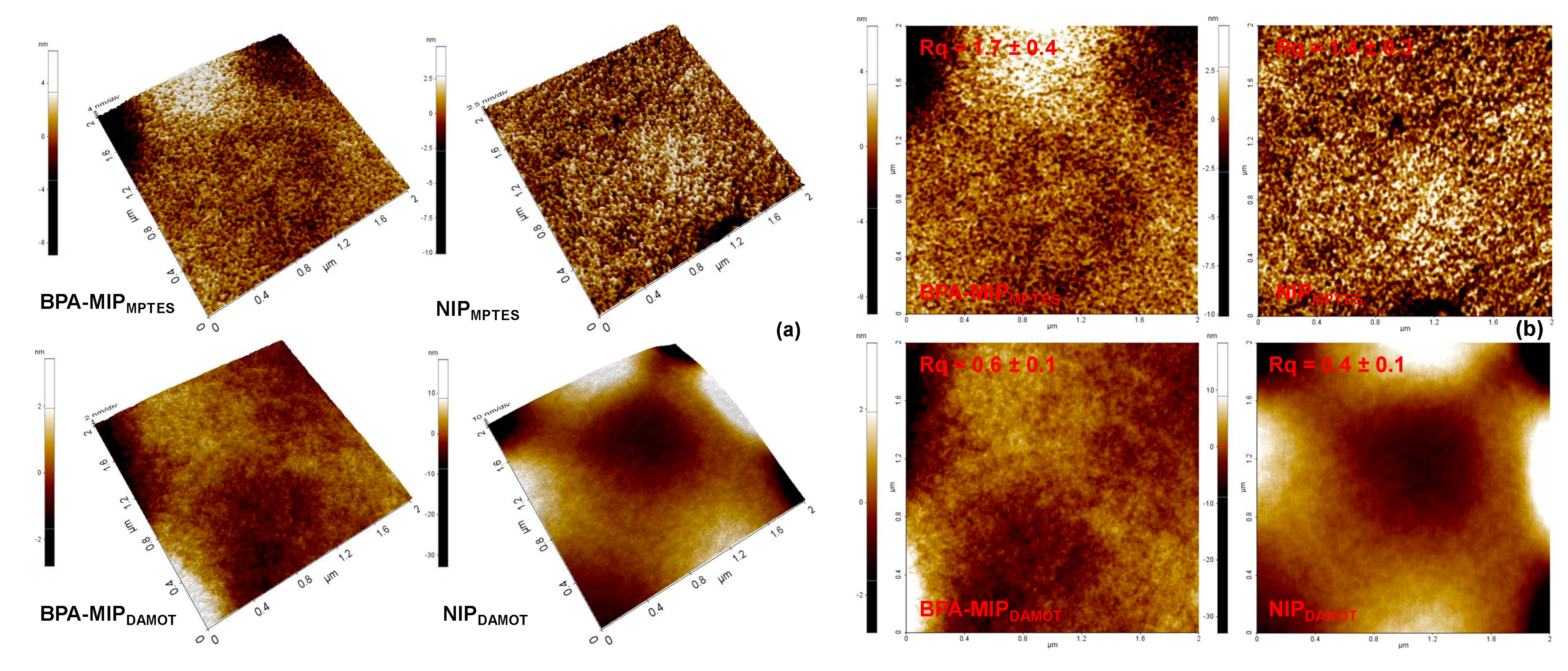
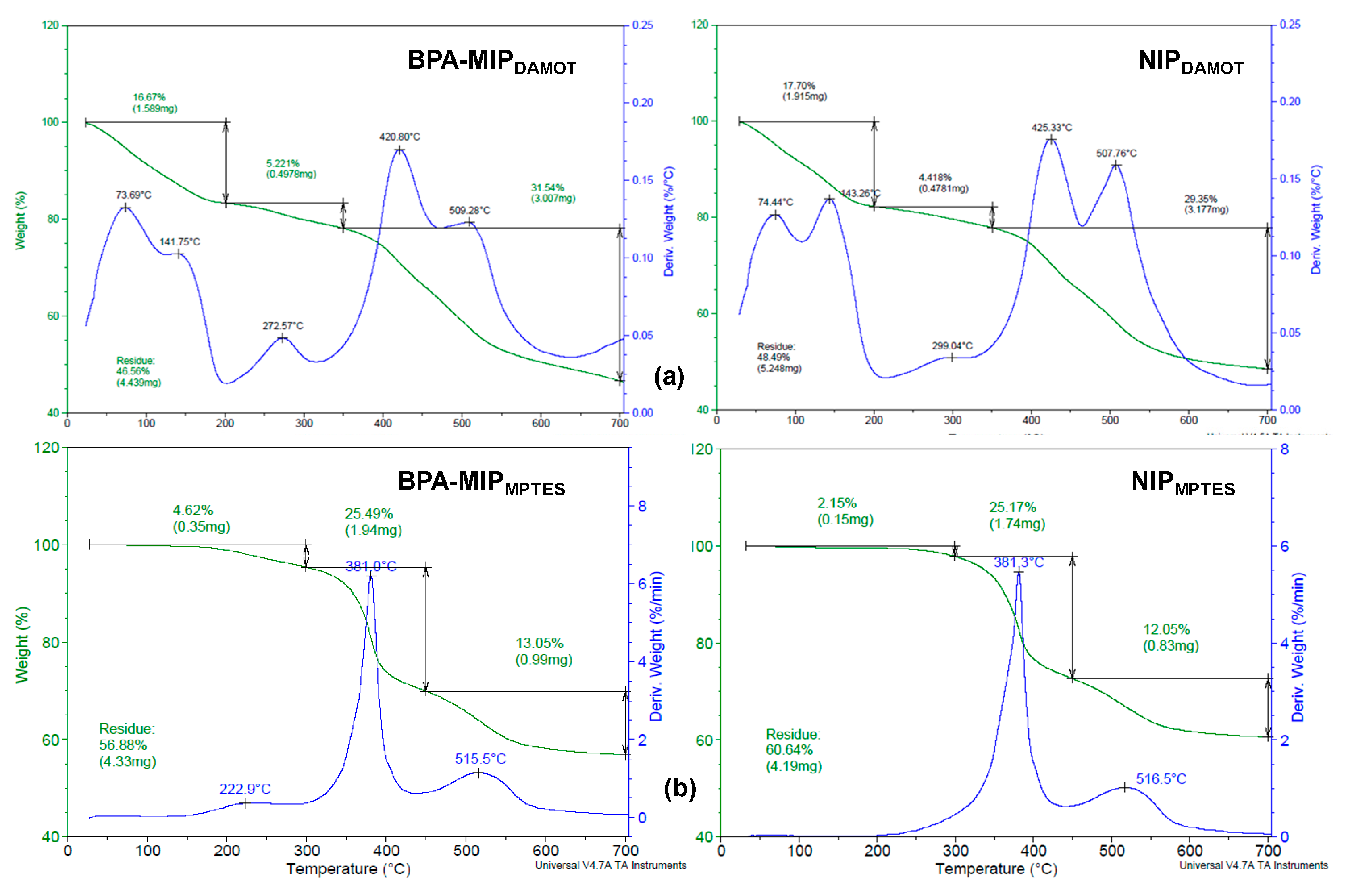
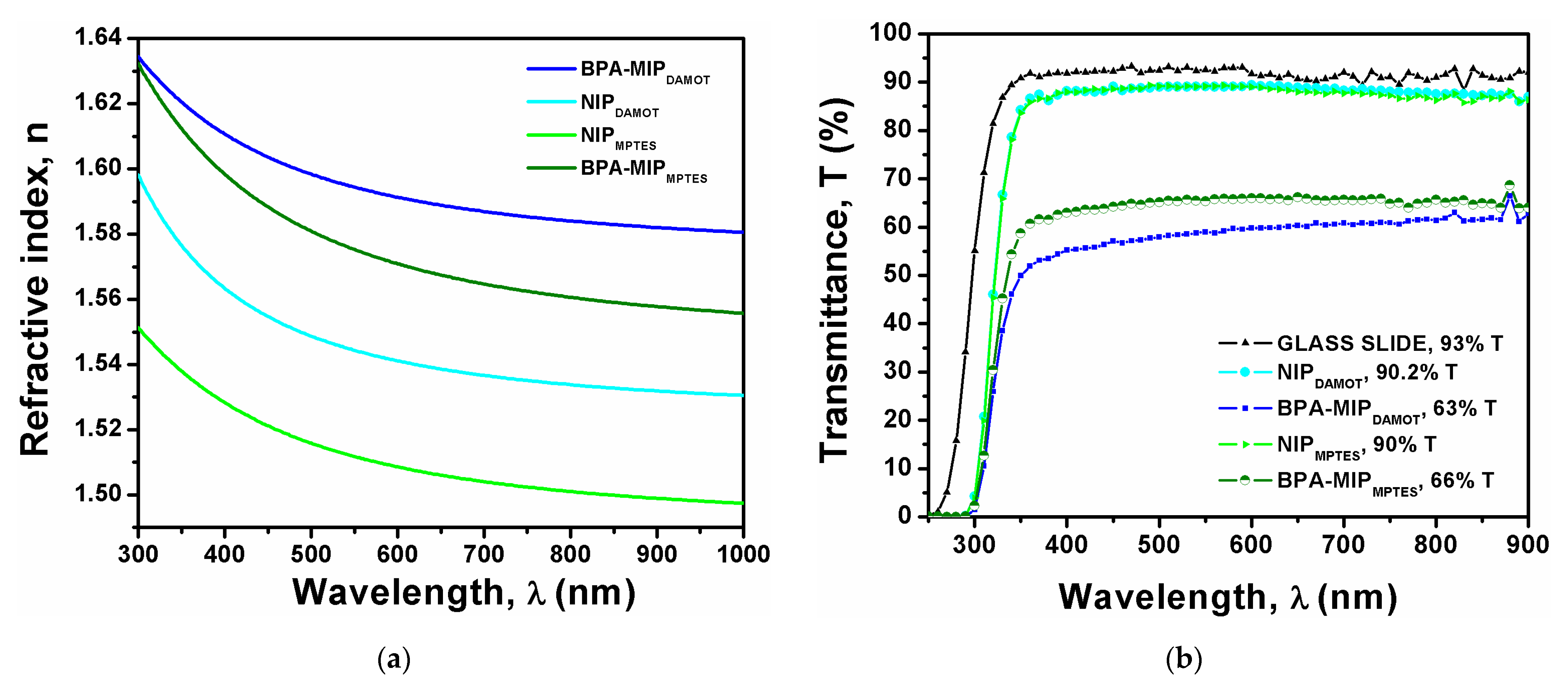
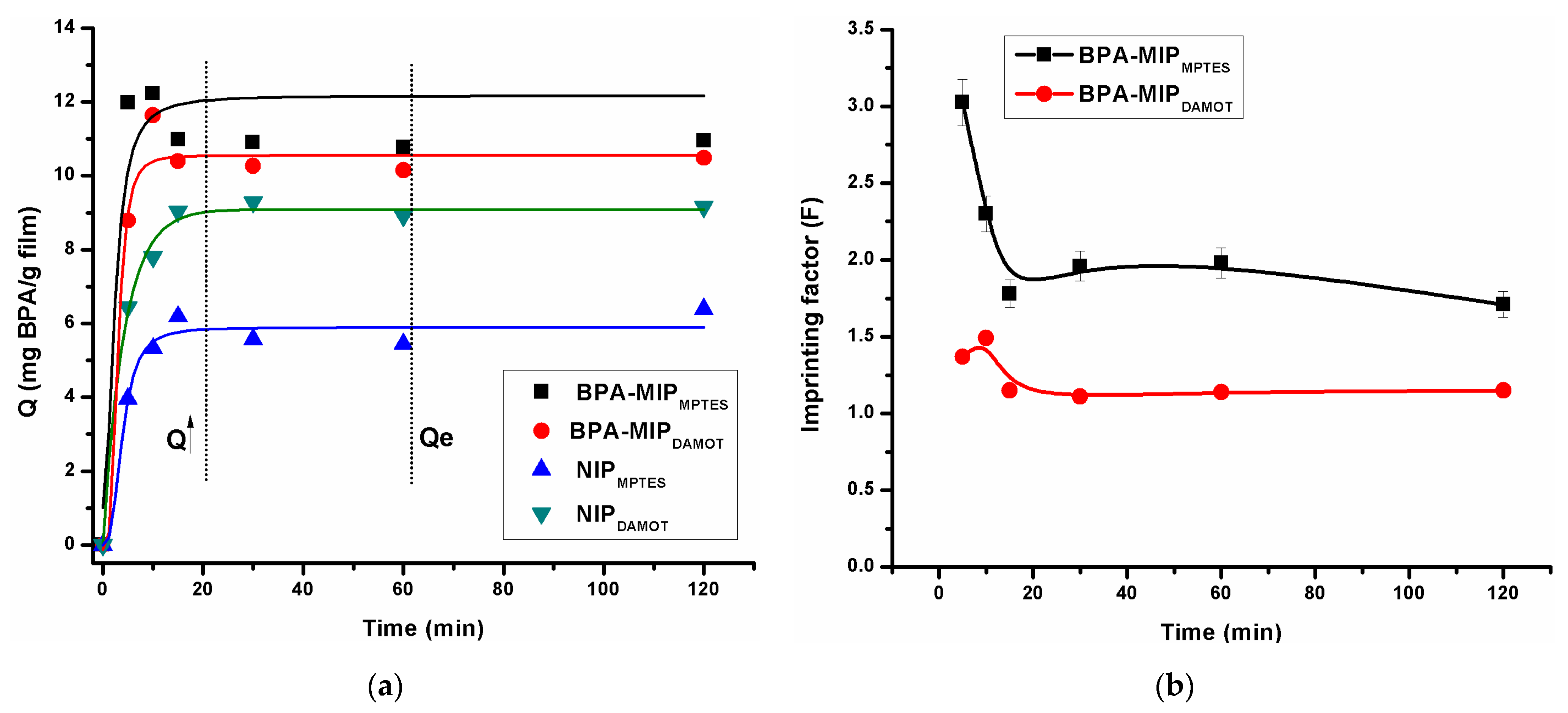

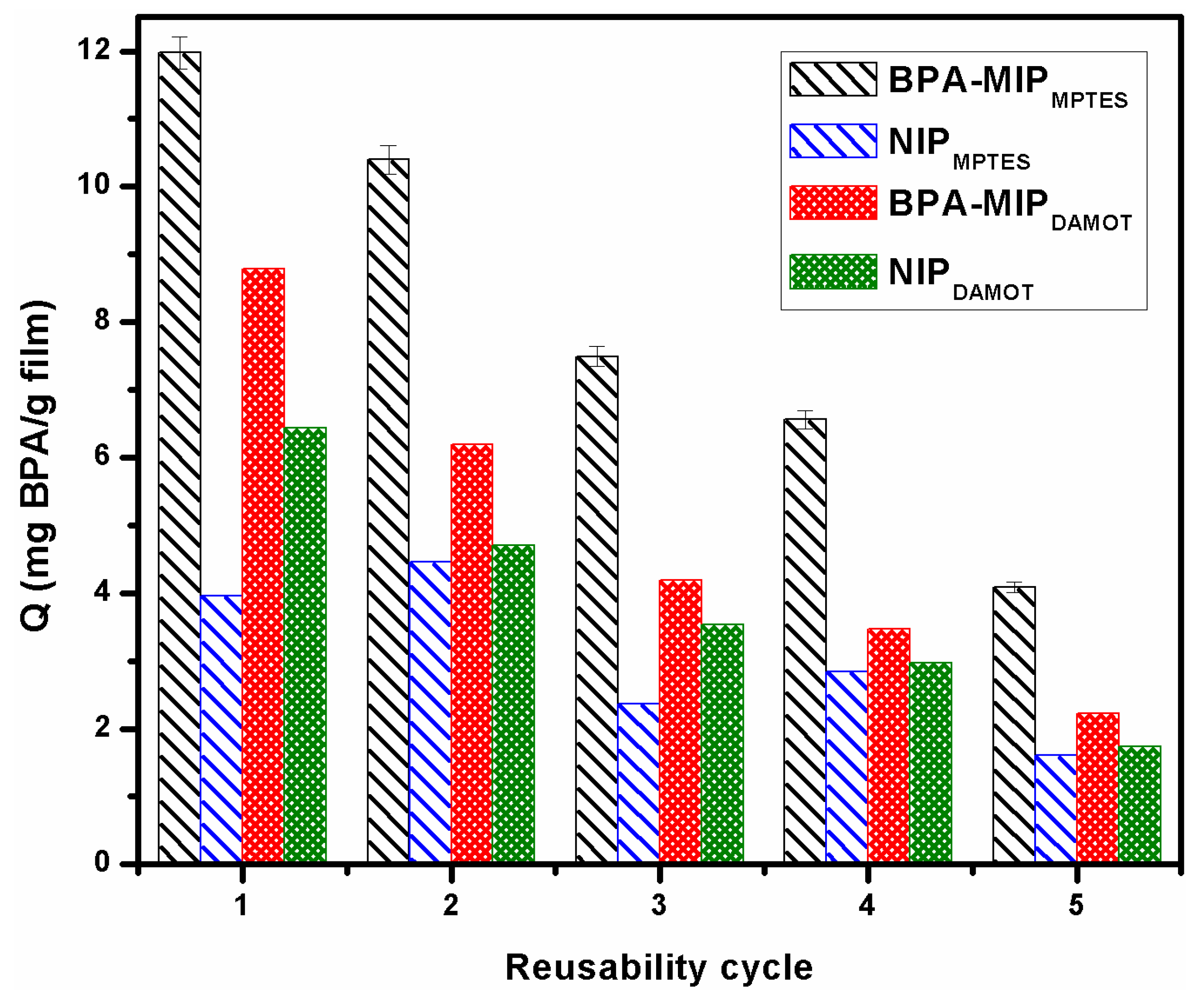
| Notation | DAMO-T (mmoles) | MPTES (mmoles) | TEOS (mmoles) | BPA (mmoles) |
|---|---|---|---|---|
| BPA-MIPMPTES | 0 | 0.364 | 0 | 0.0364 |
| NIPMPTES | 0 | 0.364 | 0 | 0 |
| BPA-MIPDAMOT | 0.364 | 0 | 0.0058 | 0.0364 |
| NIPDAMOT | 0.364 | 0 | 0.0058 | 0 |
| Film | dlayer [nm] | Roughness [nm] | MSE |
|---|---|---|---|
| BPA-MIPDAMOT | 2897.58 | 0.62 | 0.49 |
| NIPDAMOT | 3156.57 | 0.32 | 0.52 |
| BPA-MIPMPTES | 237.36 | 1.31 | 0.46 |
| NIPMPTES | 290.33 | 0.97 | 1.63 |
Publisher’s Note: MDPI stays neutral with regard to jurisdictional claims in published maps and institutional affiliations. |
© 2021 by the authors. Licensee MDPI, Basel, Switzerland. This article is an open access article distributed under the terms and conditions of the Creative Commons Attribution (CC BY) license (http://creativecommons.org/licenses/by/4.0/).
Share and Cite
Gavrila, A.-M.; Radu, I.-C.; Stroescu, H.; Zaharia, A.; Stoica, E.-B.; Ciurlica, A.-L.; Iordache, T.-V.; Sârbu, A. Role of Functional Monomers upon the Properties of Bisphenol A Molecularly Imprinted Silica Films. Appl. Sci. 2021, 11, 2956. https://doi.org/10.3390/app11072956
Gavrila A-M, Radu I-C, Stroescu H, Zaharia A, Stoica E-B, Ciurlica A-L, Iordache T-V, Sârbu A. Role of Functional Monomers upon the Properties of Bisphenol A Molecularly Imprinted Silica Films. Applied Sciences. 2021; 11(7):2956. https://doi.org/10.3390/app11072956
Chicago/Turabian StyleGavrila, Ana-Mihaela, Ionut-Cristian Radu, Hermine Stroescu, Anamaria Zaharia, Elena-Bianca Stoica, Ana-Lorena Ciurlica, Tanţa-Verona Iordache, and Andrei Sârbu. 2021. "Role of Functional Monomers upon the Properties of Bisphenol A Molecularly Imprinted Silica Films" Applied Sciences 11, no. 7: 2956. https://doi.org/10.3390/app11072956
APA StyleGavrila, A.-M., Radu, I.-C., Stroescu, H., Zaharia, A., Stoica, E.-B., Ciurlica, A.-L., Iordache, T.-V., & Sârbu, A. (2021). Role of Functional Monomers upon the Properties of Bisphenol A Molecularly Imprinted Silica Films. Applied Sciences, 11(7), 2956. https://doi.org/10.3390/app11072956










